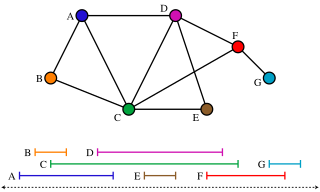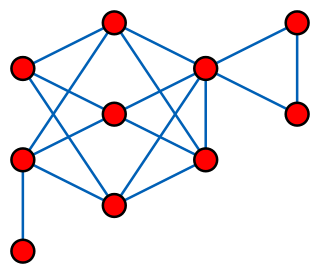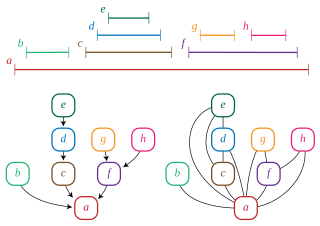Related Research Articles
This is a glossary of graph theory. Graph theory is the study of graphs, systems of nodes or vertices connected in pairs by lines or edges.

In graph theory, an outerplanar graph is a graph that has a planar drawing for which all vertices belong to the outer face of the drawing.

In graph theory, an interval graph is an undirected graph formed from a set of intervals on the real line, with a vertex for each interval and an edge between vertices whose intervals intersect. It is the intersection graph of the intervals.

In graph theory, a perfect graph is a graph in which the chromatic number of every induced subgraph equals the order of the largest clique of that subgraph. Equivalently stated in symbolic terms an arbitrary graph is perfect if and only if for all we have .
In graph theory, the perfect graph theorem of László Lovász states that an undirected graph is perfect if and only if its complement graph is also perfect. This result had been conjectured by Berge, and it is sometimes called the weak perfect graph theorem to distinguish it from the strong perfect graph theorem characterizing perfect graphs by their forbidden induced subgraphs.

In the mathematical area of graph theory, a chordal graph is one in which all cycles of four or more vertices have a chord, which is an edge that is not part of the cycle but connects two vertices of the cycle. Equivalently, every induced cycle in the graph should have exactly three vertices. The chordal graphs may also be characterized as the graphs that have perfect elimination orderings, as the graphs in which each minimal separator is a clique, and as the intersection graphs of subtrees of a tree. They are sometimes also called rigid circuit graphs or triangulated graphs.
In mathematics, in the areas of order theory and combinatorics, Dilworth's theorem characterizes the width of any finite partially ordered set in terms of a partition of the order into a minimum number of chains. It is named for the mathematician Robert P. Dilworth (1950).

In graph theory, a cograph, or complement-reducible graph, or P4-free graph, is a graph that can be generated from the single-vertex graph K1 by complementation and disjoint union. That is, the family of cographs is the smallest class of graphs that includes K1 and is closed under complementation and disjoint union.
In graph theory, a comparability graph is an undirected graph that connects pairs of elements that are comparable to each other in a partial order. Comparability graphs have also been called transitively orientable graphs, partially orderable graphs, containment graphs, and divisor graphs. An incomparability graph is an undirected graph that connects pairs of elements that are not comparable to each other in a partial order.

In graph theory, the clique-width of a graph is a parameter that describes the structural complexity of the graph; it is closely related to treewidth, but unlike treewidth it can be bounded even for dense graphs. It is defined as the minimum number of labels needed to construct by means of the following 4 operations :
- Creation of a new vertex v with label i
- Disjoint union of two labeled graphs G and H
- Joining by an edge every vertex labeled i to every vertex labeled j, where
- Renaming label i to label j

In graph theory, a branch of discrete mathematics, a distance-hereditary graph is a graph in which the distances in any connected induced subgraph are the same as they are in the original graph. Thus, any induced subgraph inherits the distances of the larger graph.

In graph theory, a trivially perfect graph is a graph with the property that in each of its induced subgraphs the size of the maximum independent set equals the number of maximal cliques. Trivially perfect graphs were first studied by but were named by Golumbic (1978); Golumbic writes that "the name was chosen since it is trivial to show that such a graph is perfect." Trivially perfect graphs are also known as comparability graphs of trees, arborescent comparability graphs, and quasi-threshold graphs.

In the study of graph coloring problems in mathematics and computer science, a greedy coloring or sequential coloring is a coloring of the vertices of a graph formed by a greedy algorithm that considers the vertices of the graph in sequence and assigns each vertex its first available color. Greedy colorings can be found in linear time, but they do not in general use the minimum number of colors possible.
In computer science, lexicographic breadth-first search or Lex-BFS is a linear time algorithm for ordering the vertices of a graph. The algorithm is different from a breadth-first search, but it produces an ordering that is consistent with breadth-first search.
In the mathematical area of graph theory, an undirected graph G is strongly chordal if it is a chordal graph and every cycle of even length in G has an odd chord, i.e., an edge that connects two vertices that are an odd distance (>1) apart from each other in the cycle.
In graph theory, a branch of mathematics, an indifference graph is an undirected graph constructed by assigning a real number to each vertex and connecting two vertices by an edge when their numbers are within one unit of each other. Indifference graphs are also the intersection graphs of sets of unit intervals, or of properly nested intervals. Based on these two types of interval representations, these graphs are also called unit interval graphs or proper interval graphs; they form a subclass of the interval graphs.
In the mathematical area of graph theory, a chordal bipartite graph is a bipartite graph B = (X,Y,E) in which every cycle of length at least 6 in B has a chord, i.e., an edge that connects two vertices that are a distance > 1 apart from each other in the cycle. A better name would be weakly chordal and bipartite since chordal bipartite graphs are in general not chordal as the induced cycle of length 4 shows.
In the mathematical area of graph theory, an undirected graph G is dually chordal if the hypergraph of its maximal cliques is a hypertree. The name comes from the fact that a graph is chordal if and only if the hypergraph of its maximal cliques is the dual of a hypertree. Originally, these graphs were defined by maximum neighborhood orderings and have a variety of different characterizations. Unlike for chordal graphs, the property of being dually chordal is not hereditary, i.e., induced subgraphs of a dually chordal graph are not necessarily dually chordal, and a dually chordal graph is in general not a perfect graph. Dually chordal graphs appeared first under the name HT-graphs.
In graph theory, a cop-win graph is an undirected graph on which the pursuer (cop) can always win a pursuit-evasion game in which he chases a robber, the players alternately moving along an edge of a graph or staying put, until the cop lands on the robber's vertex. Finite cop-win graphs are also called dismantlable graphs or constructible graphs, because they can be dismantled by repeatedly removing a dominated vertex or constructed by repeatedly adding such a vertex. The cop-win graphs can be recognized in polynomial time by a greedy algorithm that constructs a dismantling order. They include the chordal graphs, and the graphs that contain a universal vertex.

In graph theory, a subfield of mathematics, a well-colored graph is an undirected graph for which greedy coloring uses the same number of colors regardless of the order in which colors are chosen for its vertices. That is, for these graphs, the chromatic number and Grundy number are equal.
References
- Brandstädt, Andreas; Le, Van Bang; Spinrad, Jeremy (1999), Graph Classes: A Survey , SIAM Monographs on Discrete Mathematics and Applications, ISBN 0-89871-432-X
- Christen, Claude A.; Selkow, Stanley M. (1979), "Some perfect coloring properties of graphs", Journal of Combinatorial Theory , Series B, 27 (1): 49–59, doi: 10.1016/0095-8956(79)90067-4 , MR 0539075
- Chvátal, Václav (1984), "Perfectly orderable graphs", in Berge, Claude; Chvátal, Václav (eds.), Topics in Perfect Graphs, Annals of Discrete Mathematics, 21, Amsterdam: North-Holland, pp. 63–68. As cited by Maffray (2003).
- Chvátal, Václav; Hoàng, Chính T.; Mahadev, N. V. R.; De Werra, D. (1987), "Four classes of perfectly orderable graphs", Journal of Graph Theory, 11 (4): 481–495, doi:10.1002/jgt.3190110405 .
- Dragan, F. F.; Nicolai, F. (1995), LexBFS-orderings of distance-hereditary graphs, Schriftenreihe des Fachbereichs Mathematik der Univ. Duisburg SM-DU-303. As cited by Brandstädt, Le & Spinrad (1999).
- Felsner, Stefan; Raghavan, Vijay; Spinrad, Jeremy (2003), "Recognition algorithms for orders of small width and graphs of small Dilworth number", Order , 20 (4): 351–364 (2004), doi:10.1023/B:ORDE.0000034609.99940.fb, MR 2079151, S2CID 1363140 .
- Golumbic, Martin Charles; Monma, Clyde L.; Trotter, William T. Jr. (1984), "Tolerance graphs", Discrete Applied Mathematics, 9 (2): 157–170, doi: 10.1016/0166-218X(84)90016-7 , MR 0761599
- Hoàng, Chính T.; Maffray, Frédéric; Olariu, Stephan; Preissmann, Myriam (1992), "A charming class of perfectly orderable graphs", Discrete Mathematics , 102 (1): 67–74, doi:10.1016/0012-365X(92)90348-J .
- Hoàng, Chính T.; Reed, Bruce A. (1989), "Some classes of perfectly orderable graphs", Journal of Graph Theory, 13 (4): 445–463, doi:10.1002/jgt.3190130407 .
- Maffray, Frédéric (2003), "On the coloration of perfect graphs", in Reed, Bruce A.; Sales, Cláudia L. (eds.), Recent Advances in Algorithms and Combinatorics, CMS Books in Mathematics, 11, Springer-Verlag, pp. 65–84, doi:10.1007/0-387-22444-0_3, ISBN 0-387-95434-1 .
- Middendorf, Matthias; Pfeiffer, Frank (1990), "On the complexity of recognizing perfectly orderable graphs", Discrete Mathematics , 80 (3): 327–333, doi: 10.1016/0012-365X(90)90251-C .
- Payan, Charles (1983), "Perfectness and Dilworth number", Discrete Mathematics , 44 (2): 229–230, doi: 10.1016/0012-365X(83)90064-X , MR 0689816 .